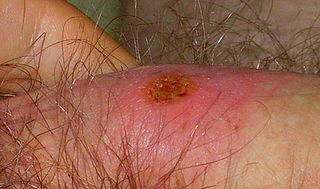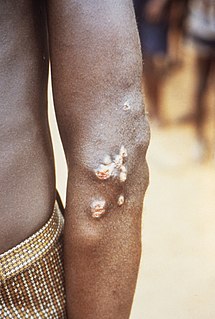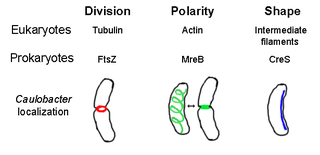
Treponema pallidum is a spirochaete bacterium with various subspecies that cause the diseases syphilis, bejel, and yaws. It is transmitted only amongst humans. It is a helically coiled microorganism usually 6–15 μm long and 0.1–0.2 μm wide. T. pallidum's lack of either tricarboxylic acid cycle or oxidative phosphorylation results in minimal metabolic activity. The treponemes have a cytoplasmic and an outer membrane. Using light microscopy, treponemes are visible only by using dark field illumination. Treponema pallidum consists of three subspecies, T. p. pallidum, T. p. endemicum, and T. p. pertenue, each of which has a distinct associated disease.

A chancre is a painless genital ulcer most commonly formed during the primary stage of syphilis. This infectious lesion forms approximately 21 days after the initial exposure to Treponema pallidum, the gram-negative spirochaete bacterium yielding syphilis. Chancres transmit the sexually transmissible disease of syphilis through direct physical contact. These ulcers usually form on or around the anus, mouth, penis and vagina. Chancres may diminish between four and eight weeks without the application of medication.

Yaws is a tropical infection of the skin, bones, and joints caused by the spirochete bacterium Treponema pallidum pertenue. The disease begins with a round, hard swelling of the skin, 2 to 5 cm in diameter. The center may break open and form an ulcer. This initial skin lesion typically heals after 3–6 months. After weeks to years, joints and bones may become painful, fatigue may develop, and new skin lesions may appear. The skin of the palms of the hands and the soles of the feet may become thick and break open. The bones may become misshapen. After 5 years or more, large areas of skin may die, leaving scars.
Pinta is a human skin disease caused by infection with the spirochete Treponema carateum, which is morphologically and serologically indistinguishable from the bacterium that causes syphilis. The disease is endemic to Mexico, Central America, and South America.

Treponema is a genus of spiral-shaped bacteria. The major treponeme species of human pathogens is Treponema pallidum, whose subspecies are responsible for diseases such as syphilis, bejel, and yaws. Treponema carateum is the cause of pinta. Treponema paraluiscuniculi is associated with syphilis in rabbits. Treponema succinifaciens has been found in the gut microbiome of traditional rural human populations.

Bejel, or endemic syphilis, is a chronic skin and tissue disease caused by infection by the endemicum subspecies of the spirochete Treponema pallidum. Bejel is one of the "endemic trepanematoses", a group that also includes yaws and pinta. Typically, endemic trepanematoses begin with localized lesions on the skin or mucous membranes. Pinta is limited to affecting the skin, whereas bejel and yaws are considered to be invasive because they can also cause disease in bone and other internal tissues.
Treponema denticola is a Gram-negative, obligate anaerobic, motile and highly proteolytic spirochete bacterium. It is one of four species of oral spirochetes to be reliably cultured, the others being Treponema pectinovorum, Treponema socranskii and Treponema vincentii. T. denticola dwells in a complex and diverse microbial community within the oral cavity and is highly specialized to survive in this environment. T. denticola is associated with the incidence and severity of human periodontal disease. Treponema denticola is one of three bacteria that form the Red Complex, the other two being Porphyromonas gingivalis and Tannerella forsythia. Together they form the major virulent pathogens that cause chronic periodontitis. Having elevated T. denticola levels in the mouth is considered one of the main etiological agents of periodontitis. T. denticola is related to the syphilis-causing obligate human pathogen, Treponema pallidum subsp. pallidum. It has also been isolated from women with bacterial vaginosis.

The prokaryotic cytoskeleton is the collective name for all structural filaments in prokaryotes. It was once thought that prokaryotic cells did not possess cytoskeletons, but advances in visualization technology and structure determination led to the discovery of filaments in these cells in the early 1990s. Not only have analogues for all major cytoskeletal proteins in eukaryotes been found in prokaryotes, cytoskeletal proteins with no known eukaryotic homologues have also been discovered. Cytoskeletal elements play essential roles in cell division, protection, shape determination, and polarity determination in various prokaryotes.
Treponematosis is a term used to individually describe any of the diseases caused by four members of the bacterial genus Treponema. The four diseases are collectively referred to as treponematoses:
The red complex is a group of bacteria that are categorized together based on their association with severe forms of periodontal disease. The red complex—among a number of other complexes—were classified by Sigmund Socransky in 1998.

The Treponema pallidum particle agglutination assay is an indirect agglutination assay used for detection and titration of antibodies against the causative agent of syphilis, Treponema pallidum subspecies pallidum. It also detects other treponematoses.
Serpulina hyodysenteriae, formerly known as Brachyspira hyodysenteriae and Treponema hyodysenteriae, is a species of bacteria.
Serpulina innocens, formerly known as Serpula innocens and formerly as Treponema innocens is a species of bacteria. The other species in this genus is Serpulina hyodysenteriae. Both species however are classified as belonging to the genus Brachyspira, together with Brachyspira pilosicoli. They are thought to be commensal bacteria.
Treponema azotonutricium is a bacterium, the first termite gut spirochete to be isolated, together with Treponema primitia.
Treponema primitia is a bacterium, the first termite gut spirochete to be isolated, together with Treponema azotonutricium.
Treponema isoptericolens is a spirochaete from the hindgut of the termite Incisitermes tabogae. Its cells are motile, helical in shape, 0.4–0.5 μm in diameter and generally 12–20 μm long; it is obligately anaerobic, with type strain SPIT5T.
Spiral bacteria, bacteria of spiral (helical) shape, form the third major morphological category of prokaryotes along with the rod-shaped bacilli and round cocci. Spiral bacteria can be subclassified by the number of twists per cell, cell thickness, cell flexibility, and motility. The two types of spiral cells are spirillum and spirochete, with spirillum being rigid with external flagella, and spirochetes being flexible with internal flagella.
Treponema socranskii was isolated from gum swabs of people with periodontitis and clinically-induced periodontitis. It is a motile, helically coiled, obligate anaerobe that grows best at 37 °C, and is a novel member of its genus because of its ability to ferment molecules that other Treponema species cannot. T. socranskii’s growth is positively correlated with gingival inflammation, which indicates that it is a leading cause of gingivitis and periodontitis.
Diversity-generating retroelements (DGRs) are a family of retroelements that were first found in Bordetella phage (BPP-1), and since been found in bacteria, Archaea, Archaean viruses, temperate phages, and lytic phages. DGRs benefit their host by mutating particular regions of specific target proteins, for instance, phage tail fiber in BPP-1, lipoprotein in legionella pneumophila, and TvpA in Treponema denticola . An error-prone reverse transcriptase is responsible for generating these hypervariable regions in target proteins. In mutagenic retrohoming, a mutagenized cDNA is reverse transcribed from a template region (TR), and is replaced with a segment similar to the template region called variable region (VR). Accessory variability determinant (Avd) protein is another component of DGRs, and its complex formation with the error-prone RT is of importance to mutagenic rehoming.
Treponema paraluiscuniculi is a Gram-negative, spiral-shaped bacterium. It is the etiologic agent of "Rabbit Syphilis". This condition occurs occasionally in laboratory rabbits, pet rabbits, and wild rabbits, but is not considered a significant cause of morbidity.






